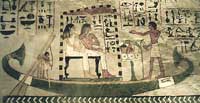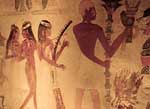|
Valley of the Nobles
 The Tombs of the Nobles actually comprises a number of distinct
areas on the West Bank at modern Luxor (Ancient Thebes). These
areas mostly lie in five different regions. The Tombs of the Nobles actually comprises a number of distinct
areas on the West Bank at modern Luxor (Ancient Thebes). These
areas mostly lie in five different regions.
The tombs at the Valley of the Nobles are much smaller and
display different drawings than those found at the tombs of the
Valley of the Kings.
No scenes of the journey to the "Afterworld" are found.
Instead, detailed pictures of a noble's daily life during the
New Kingdom are depicted: agricultural scenes, hunting and
fishing scenes, festivals and ceremonies, musicians and dancers,
maids and servants, craftsmen and artisans.
Here one finds some of the most beautiful private tombs on the
West Bank.
 Rekhmire Rekhmire
The vizier under Tuthmosis III and Amenhotep II was responsible
for taxation, justice and foreign policy. The reliefs in his
tomb depicts tribute being brought to Egypt, a procession of
African beast and goods and Rekhmire's coronation a vizier.
 Sennefer Sennefer
Sennufer was mayor of Thebes and overseer of the gardens of Amun
during the reign of Amenhotep II. The antechamber of his tomb is
decorated with reliefs of grape arbors.
 Menna Menna
Hunting and fishing scenes adorn the chambers of this 28th
dynasty estate inspector's tomb.
 Nakht Nakht
This tomb contains well preserved reliefs of everyday country
life.
 Ramose Ramose
Ramose was governor of Thebes during Amenhotep IV's reign. Work
was begun on this impressive tomb in the classical Egyptian
style, but on into the tomb, changed to the Amarnan style. This
was because Amenhotep IV had become Akhenaton. When Akhenaton
went to Amarna, Ramose followed, thus leaving the tomb
unfinished.
 Userhat Userhat
The royal scribe and tutor decorated his tomb with hunting
scenes and barbers cutting hair.
 Khaemhat Khaemhat
The royal scribe and granary inspector's tomb bears reliefs of
harvests, unloading of boats, a market scene, and cattle herds.
Of interest is a relief of a complete set of instruments
employed in the Opening of the Mouth ritual. |